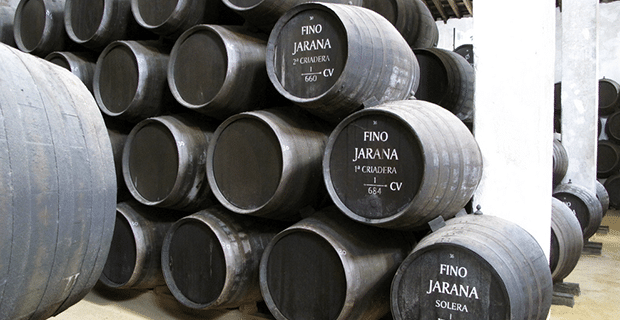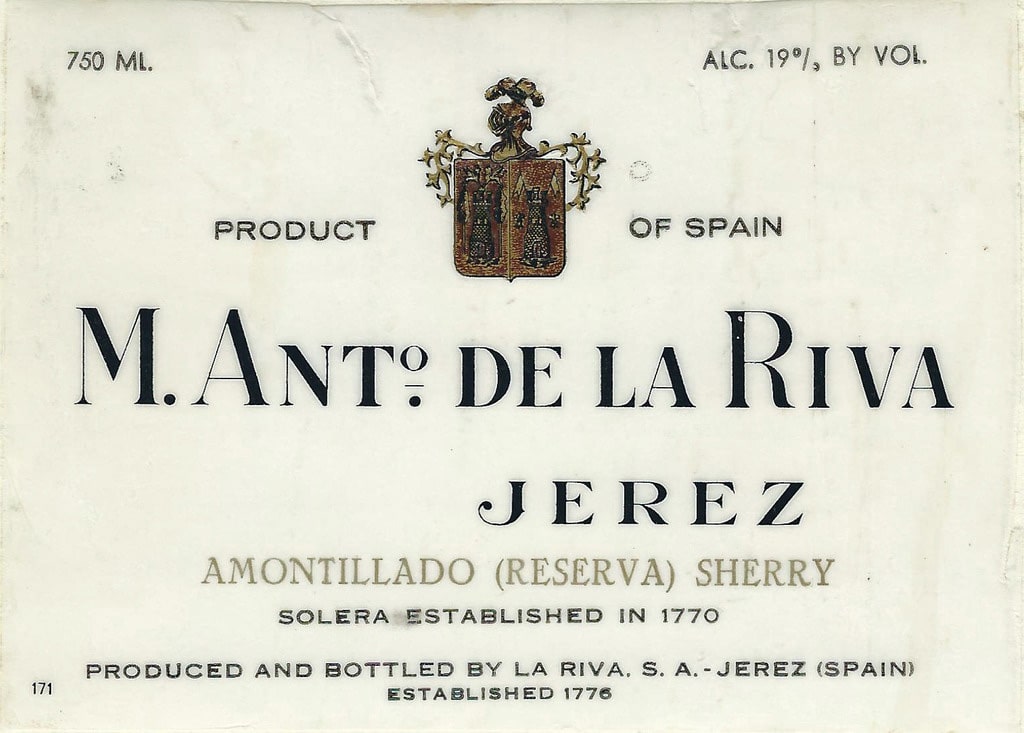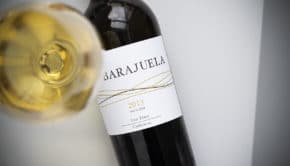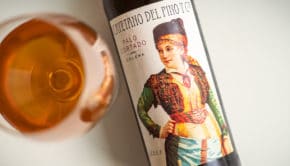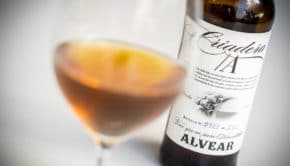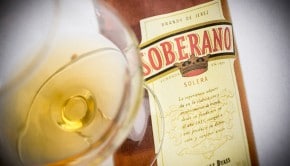The Solera system: ageing sherry
Sherry has a unique and rather complex system of maturation using a large number of casks and fractional blending. This system is called solera and it is used in the production of all types of sherry, dry or sweet. It is also commonly used for other wines, Spanish brandy, sherry vinegar, Madeira and Port wines and occasionally other drinks like whisky or beer. While the base idea is always fractional blending, we’ll now focus on how it is applied in sherry.
Soleras and criaderas
Barrels in a solera are arranged in different groups or tiers, called criaderas or nurseries. Each scale contains wine of the same age. The oldest scale, confusingly called solera as well, holds the wine ready to be bottled. When a fraction of the wine is extracted from the solera (this process is called the saca), it will be replaced with the same amount of wine from the first criadera, i.e. the one that is slightly younger and typically less complex. This, in turn, will be filled up with wine from the second criadera and so on.
The last criadera, which holds the youngest wine, is topped up with the wine from the latest harvest, named sobretabla. Taking away part of the wine and replacing it with the contents of other scales, is called rociar or to wash down.
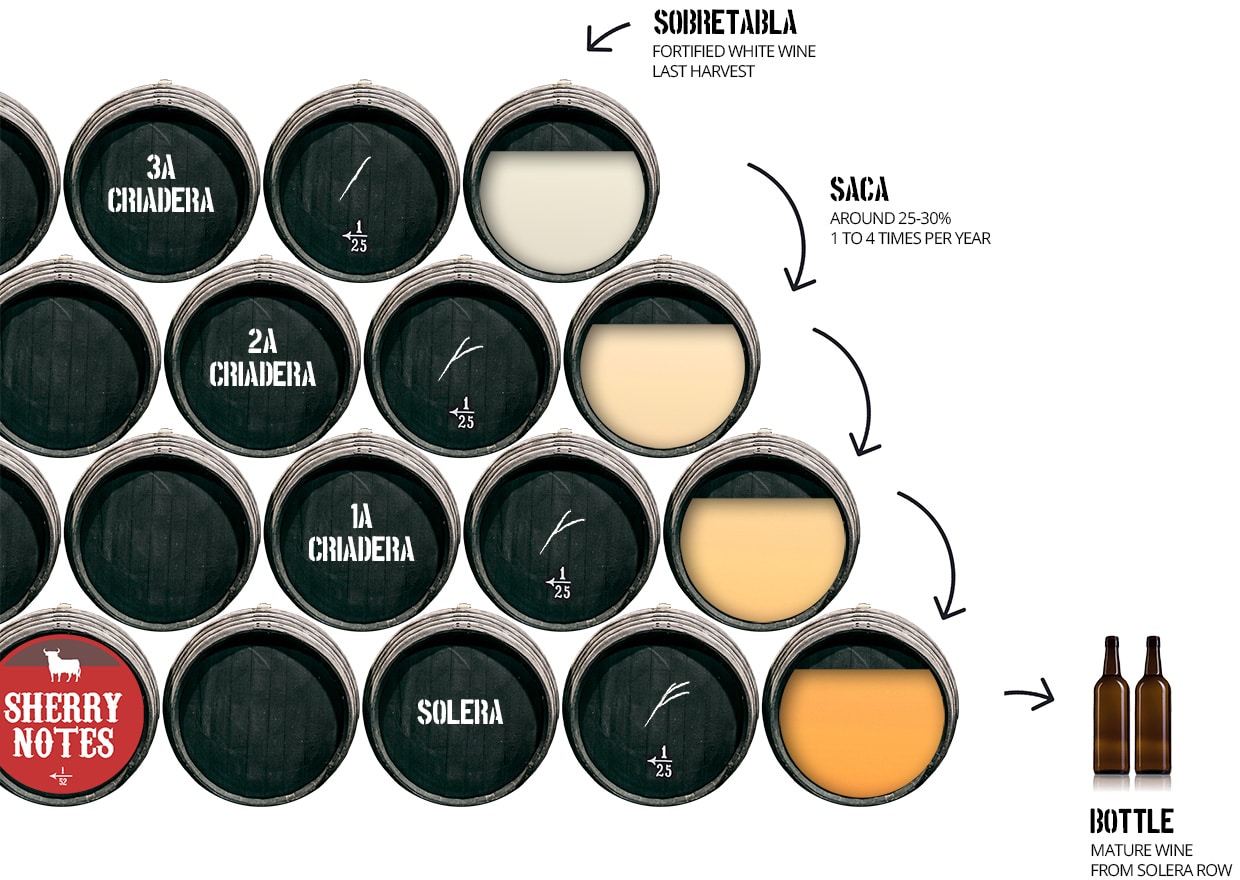
The solera system
A saca (bottling of the old wine) and rocío (replenishing the casks) will usually take place several times a year, but the actual number may vary and specific figures are rarely disclosed. In Jerez, a Fino solera will be resfreshed two to four times a year. In Sanlúcar de Barrameda, due to the higher activity of the flor, a Manzanilla solera can easily have four to six sacas a year.
Age certification
The pliego de condiciones (rules of the D.O.) states that you cannot sell more than 40% of the entire stock of a certain wine within the same year (which guarantees the required minimum age of all sherry wines). In practice though there is an unwritten rule not to go over one third in a single rocío (obviously less for Fino or Manzanilla). For older wines there is usually one saca per year so for VOS or VORS sherry you need to prove that you keep X times the age statement in stock (e.g. 20x the amount for VOS wines).
This process used to be manual labour, filling a jarra or jar with a hose and pouring it into a cask on the next level. Nowadays this is automated by usind what is called the octopus, a pump with several arms which allows a strict amount of wine being taken out of several barrels at the same time. Mind that wine from a certain scale is generally blended in a tank before being pumped to the next level, resulting in a more consistent character. Some producers like Bodegas Tradición are still working in the old way, without automation.
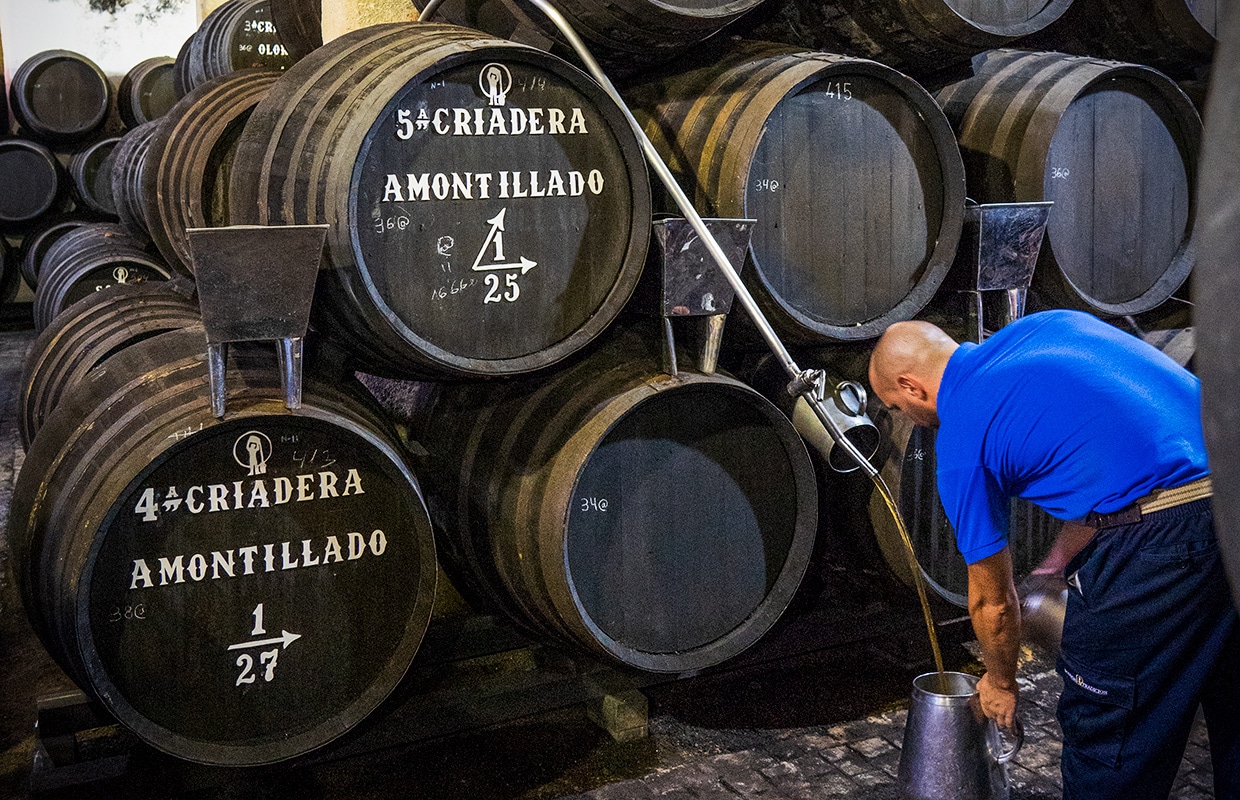
Rociar, or refreshing the solera by hand at Bodegas Tradición
Origins of the solera system
The dynamic ageing method is believed to have originated in Sanlúcar de Barrameda in the second part of the 18th century, probably around 1760, and shortly after in Jerez. Prior to this, all sherries were bottled as añadas or vintage wines, a concept that was still widely in use until the 20th century. At first it consisted of blending wine from the previous harvest (then called vino añejo, trasañejo or reañejo) with the new production, gradually evolving to a system of blending statically aged wines of different ages. Each wine was given a numeric value from 1 to 8, roughly related to its average age.
It wasn’t until the mid 19th century that the solera system was used as the current practice of dynamically ageing wine in gradually evolving stages with regular, systematic refreshments. This also marks the beginning of the terminology solera y criaderas. The solera system was developed around the same time when ageing under flor became an established method. For oxidative wines (Oloroso-style) the solera system started to be used even later, in the 19th century.
Some of the oldest soleras still in use are now at Osborne (Capuchino laid down in 1790 and Sibarita in 1792), Díez-Mérito (Fino Imperial in 1793), El Maestro Sierra (1830), Valdespino (1842) and Gonzalez Byass (1847).
The oldest reference I could find is an Amontillado solera at bodegas M. Antonio de la Riva which was established in 1770. Harveys (Bodegas Fundador) claim to have older soleras founded in 1740 (Oloroso Ardila and Palo Cortado La Riva). Such dates should always be taken with a grain of salt, usually there’s very little proof. In any case none of the original barrels could have survived, it’s a dynamic system after all.
Organisation of a solera
Although a solera is usually represented as layers of casks stacked upon each other, with the solera level at the bottom of the pile (hence the name, suelo = floor), this is only the case for small soleras, or in bodegas where tours are being held. Usually barrels are stacked in blocks of casks rather than actual rows. We are talking about potentially hundreds of casks here, so sometimes a whole room is filled with just one criadera. Some of the largest soleras are distributed over different buildings.
Apart from the size of some soleras, there are two technical reasons behind this distribution: firstly, stability can become problematic when more than four casks are placed on top of each other, and secondly, it is better to place Fino and Manzanilla casks near the floor, where it is cooler, and oxidative types of sherry towards the top. A Manzanilla solera will usually be limited to three rows as the air becomes too hot and dry if you go higher.
The number of tiers between the solera and the last criadera varies largely and depends on the style of the wine and the preferences of the bodega. In general, Manzanilla and Fino soleras will have more criaderas than those of Oloroso and other oxidatively aged sherry, and in general older wines will have less criaderas. A typical Fino solera will roughly range between three and seven criaderas. A Manzanilla solera can easily have eight or nine criaderas, even up to fifteen.
Mixing different criaderas
Mind that wines are not necessarily drawn entirely from the oldest row. For instance the famous Fino Inocente is always a mix of wine from the oldest solera and the first criadera. The small differences in these stages allow the cellarmaster to work with variations and ‘compose’ the same profile regardless of the seasonal differences. Similarly some wines are a mix of different soleras.
For Tio Pepe Gonzalez Byass maintains 21 distinct solera systems (with a total of 22,000 barrels), all managed in basically the same way with the same base wines, but with tiny (natural) differences. The final wine for Tio Pepe is then blended from all these different systems.
Also some solera systems are linked to each other. The Palo Cortado Viejo CP is an entire solera system of five stages, resulting in a commercially available Palo Cortado of around 20 years. However this mature wine is also used to feed the youngest criadera of another solera system for the Palo Cortado Cardenal. Here the original Viejo CP ages further and becomes a 50-60 years old VORS wine bottled under a different name.
Age of a solera
It is impossible to give the exact age of a wine that has been aged in a solera, as it is a blend of many vintages. It is only possible to give an approximate, average age of the wine. This is determined by the number of criaderas, the typical percentage of each saca, and the frequency of the saca. The combination of these factors defines the rotation of the total stock of wine and allows us to estimate the average age.
A wine bottled from a solera that was started ten years ago will have wine that is ten years old blended with wine that is nine, eight, seven… up to the wine of the latest harvest. By law, sherry must reach an average age of two years before it can be sold, but in reality most are older than that (the average of all sherry currently in stock in bodegas is around 4 years). A tasting panel of the Consejo Regulador can reject any wine if it deems to be immature. They are also the ones who grant the VOS and VORS labels by assessing the flavour profile.
Average age vs. foundation year
While we said earlier that the highest criadera is topped up with young wine, premium soleras that hold very old wines will be washed down with soleras of similar style, i.e. already mature wine brought to a certain state of aging outside of the solera. This idea can also used to expand an existing solera, bringing casks to a required state before adding them. Sherry soleras are rarely started from scratch, most of the time they start from existing wines.
Note that in the past it was common to name a solera after its foundation year, leading to confusion with consumers who think this is the vintage of the wine. Though most producers now avoid it, some current-day names are still on the edge, e.g. Gonzalez Byass Solera 1847. It is often claimed that a solera always contains a tiny amount of wine from the foundation of the solera, but in reality this is not the case. The oldest particles in a solera have been proven to be around 60-80 years old.
Purpose of a solera
The most significant result of the solera system is ensuring continuity and consistency. By blending multiple vintages, the possible variability of each year will be lowered and – after a certain amount of years – the bottled wine will maintain a constant average age. New wines are only gradually introduced to the system, and the influence of the new wine will disappear as it takes on the characteristics of the older sherry quite rapidly.
Furthermore, the solera system is essential for biological ageing under flor since every refreshment brings in young wine that contains the necessary micro-nutrients to support the yeast. Without this regular nutritional input, the layer of flor will die and the sherry will continue its maturation in an oxidative way. Note that the new wine is never poured in directly from the top, it is introduced in the cask gently and always underneath the film of flor without damaging it.
To sum up, a solera is essentially a never-ending ageing system, gradually but slowly growing older. Once mature and maintained in a proper way, it will show a unique personality, the identity of the solera.


